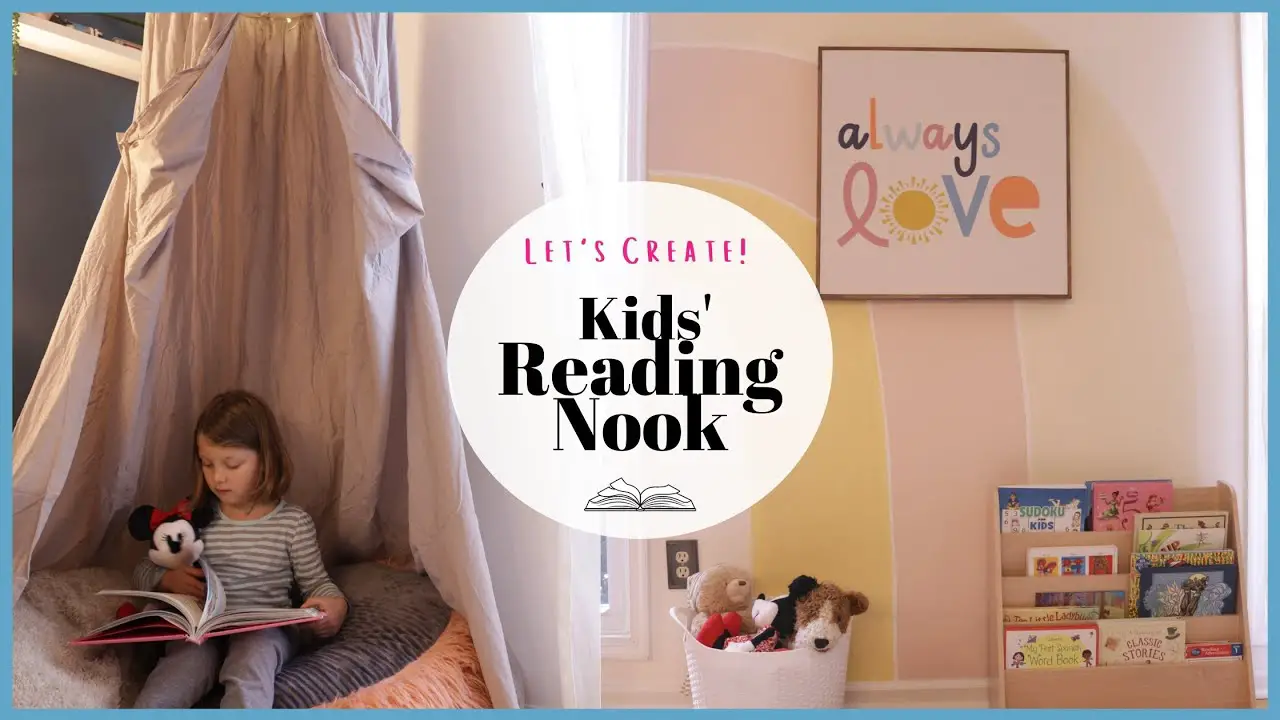There’s something magical about a cozy corner filled with books. It’s a place where imagination takes flight, and stories come alive. I’ve always believed that creating a special space for children to read can inspire a lifelong love for books. That’s why I’m excited to share 11 creative reading nook ideas designed just for kids.
Each idea is unique, from vibrant teepees to clever closet conversions. These designs not only add charm to a room but also make reading an adventure. A well-lit, colorful book nook can transform even the smallest corner into a magical retreat.
I’ve included safety tips and simple projects to help you get started. Whether you’re crafting a custom bench or adding soft cushions, these ideas combine style and function. Let’s turn that unused space into a haven where your child can curl up with their favorite stories.
Key Takeaways
- Create a cozy and inviting space to encourage a love for books.
- Explore 11 unique designs, including teepees and closet conversions.
- Focus on well-lit and colorful areas to make reading enjoyable.
- Combine style and function with simple, safe DIY projects.
- Transform any small corner into a magical retreat for your child.
Introduction to Creating a Cozy Reading Spot
Every child deserves a special spot where stories come to life. A dedicated space for books can inspire creativity and make reading an adventure. I’ve always believed that a cozy corner can nurture a love for stories, and that’s what motivated me to create these unique reading nook ideas.
When I started this project, I wanted to design a room that felt inviting and magical. I drew inspiration from expert designers like Marian Louise Designs and Sonya Lee Architect. Their work showed me how even the smallest corner can become a dedicated retreat for books.
My Inspiration for a Kid-Friendly Space
My journey began with a simple idea: to create a space where my child could escape into the world of books. I wanted it to be colorful, comfortable, and full of personality. From soft cushions to whimsical lighting, every detail was carefully chosen to make the area feel special.
I also looked at current interior design trends for inspiration. Bright colors, playful themes, and functional furniture all played a role in shaping my vision. The goal was to make the room both practical and enchanting.
Overview of the DIY Journey
Creating a reading nook was a rewarding experience. I started by selecting the perfect corner and then added elements like seating, storage, and lighting. Each step was an opportunity to infuse creativity and thoughtfulness into the space.
One of the biggest challenges was balancing style with safety. I chose durable materials and ensured everything was secure for my growing child. The result was a cozy retreat that not only looked beautiful but also encouraged a love for books.
Through this process, I learned that even small changes can make a big difference. A well-designed reading nook can transform any area into a magical escape for your kid.
Choosing the Perfect DIY Reading Nook For Kids
Finding the right spot for a cozy retreat is easier than you think. A well-designed reading nook can transform any corner into a magical escape. Start by considering your child’s needs and the available space in their room.
When selecting a style, think about functionality and aesthetic appeal. Built-in shelves are great for maximizing space, while freestanding structures like teepees add a playful touch. Both options can be customized to match your child’s interests.
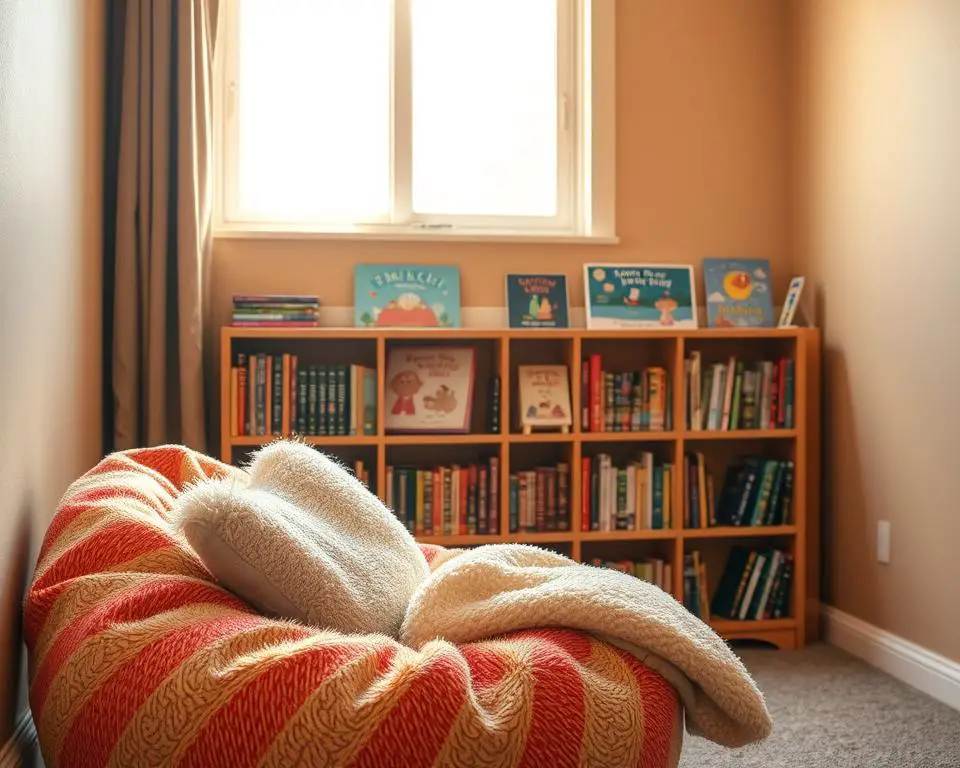
Natural light is key to creating an inviting atmosphere. Position the nook near a window if possible. Safe materials and personalized accents, like favorite colors or themes, make the space feel special.
Versatility is another important factor. Choose a design that can grow with your kid. Modular furniture or adjustable shelving ensures the reading nook remains functional as they age.
Finally, visualize how the design will integrate into your home. A cohesive look ties the space together, making it a seamless part of the room. With these tips, you’ll create a book-filled haven your child will love.
Understanding the Benefits of a Reading Nook
A dedicated reading space can be a game-changer for a child’s development. It’s not just about creating a cozy corner; it’s about fostering creativity, focus, and a love for books. Let’s explore how a well-designed nook can make a lasting impact.
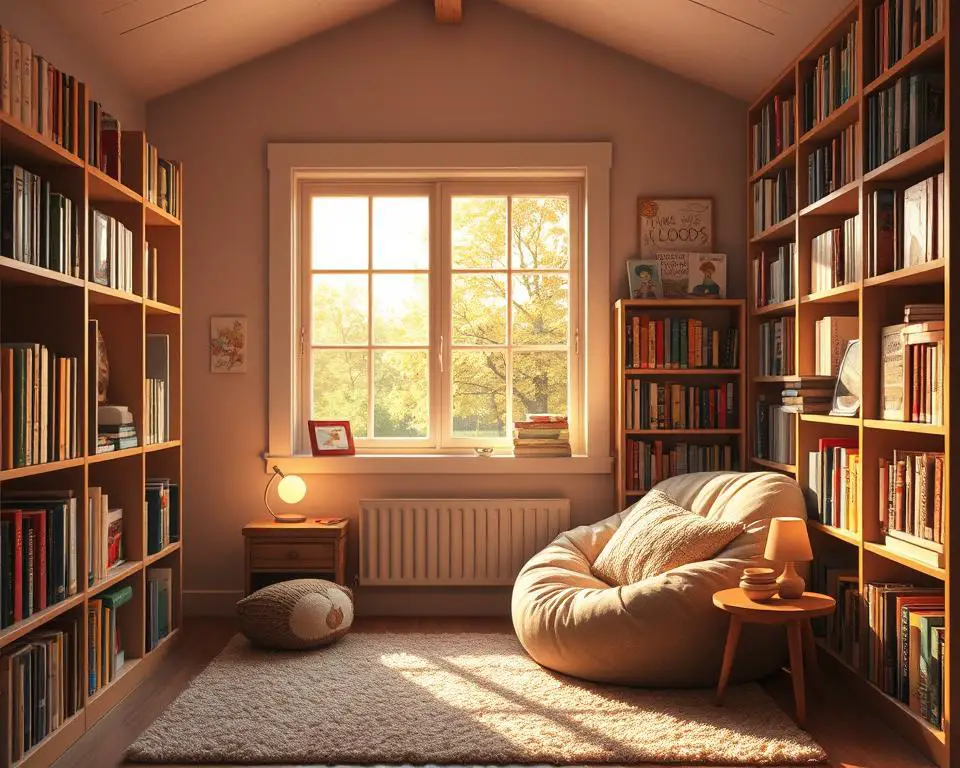
Boosting Imagination and Creativity
A personalized reading nook can spark a child’s imagination. When surrounded by their favorite books and themes, they’re more likely to dive into stories and create their own adventures. For example, a themed nook like an enchanted forest or underwater world can double as a creative play area.
Studies show that children with dedicated spaces for reading are more engaged in imaginative play. This not only enhances their creativity but also builds self-confidence as they explore new ideas.
Enhancing Focus and Relaxation
A quiet, comfortable nook can help children focus better during reading sessions. Research indicates that having a designated area reduces distractions and promotes concentration. Soft cushions, warm lighting, and a clutter-free environment create a calming atmosphere.
This dedicated space also helps reduce anxiety. Children feel secure and relaxed, making it easier for them to immerse themselves in books. Over time, this can lead to improved reading habits and a stronger connection to learning.
| Benefit | Impact |
|---|---|
| Boosts Creativity | Encourages imaginative play and storytelling. |
| Enhances Focus | Reduces distractions and improves concentration. |
| Promotes Relaxation | Creates a calming environment for reading. |
| Supports Learning | Encourages consistent reading habits. |
In conclusion, a well-thought-out reading nook offers holistic benefits for your child. It’s more than just a corner; it’s a sanctuary that nurtures their mind and soul.
Inspiring Themes and Designs for a Kid's Nook
Themes can turn any area into a world of wonder for your little one. A well-chosen design not only enhances the look of a space but also sparks creativity and imagination. Whether it’s a fairy tale teepee or an underwater adventure, the right theme can make reading an unforgettable experience.
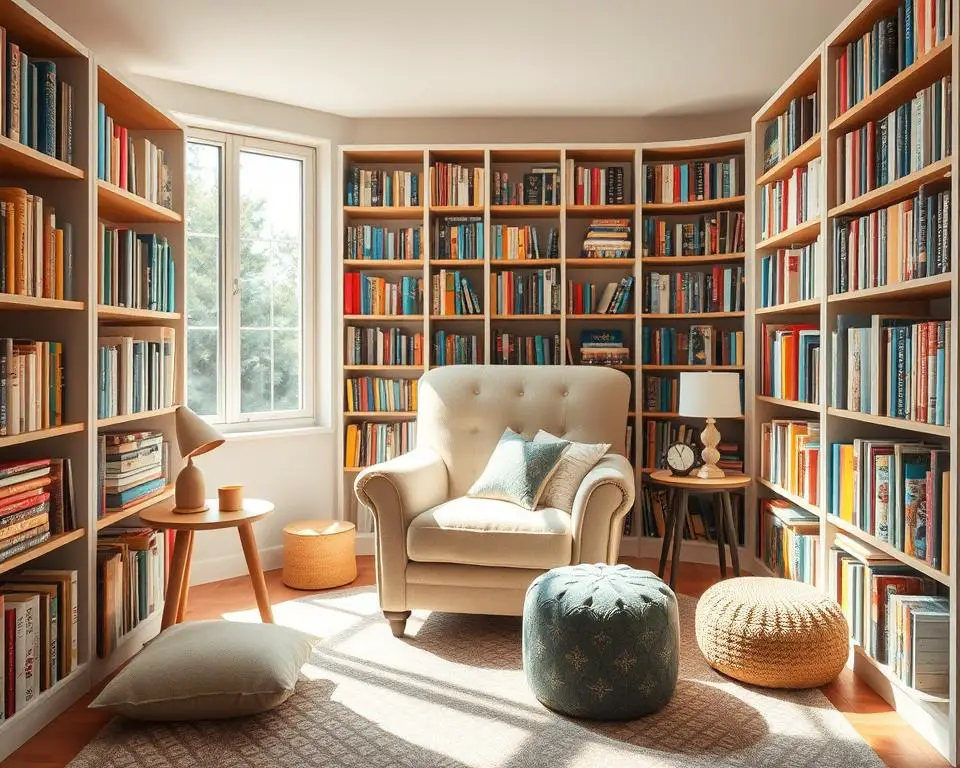
Fairy Tale Teepee and Enchanted Forests
A fairy tale teepee creates an atmosphere of exploration and magic. Soft fabrics, twinkling lights, and cozy cushions make it a perfect retreat. Add elements like faux vines, fairy lights, and woodland creatures to bring an enchanted forest to life.
Natural materials and soft colors enhance the theme. Think greens, browns, and pastels to create a calming yet whimsical environment. This design encourages storytelling and imaginative play.
Underwater Adventures and Space Themes
For a more adventurous idea, consider an underwater or space theme. Blue and silver tones, starry lights, and ocean-inspired decor can transform a corner into a new world. Wall decals of fish, planets, or rockets add a playful touch.
These themes not only stimulate imagination but also serve as a learning tool. They introduce concepts like marine life or astronomy in a fun and engaging way. Themed nooks make reading an adventure every time.
| Theme | Key Elements | Benefits |
|---|---|---|
| Fairy Tale Teepee | Soft fabrics, twinkling lights, woodland decor | Encourages storytelling and imaginative play |
| Enchanted Forest | Natural materials, soft colors, faux vines | Creates a calming and whimsical environment |
| Underwater Adventure | Blue tones, ocean-inspired decor, wall decals | Introduces marine life concepts in a fun way |
| Space Theme | Silver tones, starry lights, rocket decor | Engages curiosity about astronomy |
No matter the theme, the key is to choose one that resonates with your child. A personalized space not only looks great but also makes reading a cherished activity. Even a small corner can tell a big story with the right design.
Essential Elements for a Kid-Friendly Reading Space
Creating a welcoming space for your child to explore books is both fun and rewarding. A well-thought-out reading space combines comfort, functionality, and style. Let’s dive into the must-have features that make this area truly special.
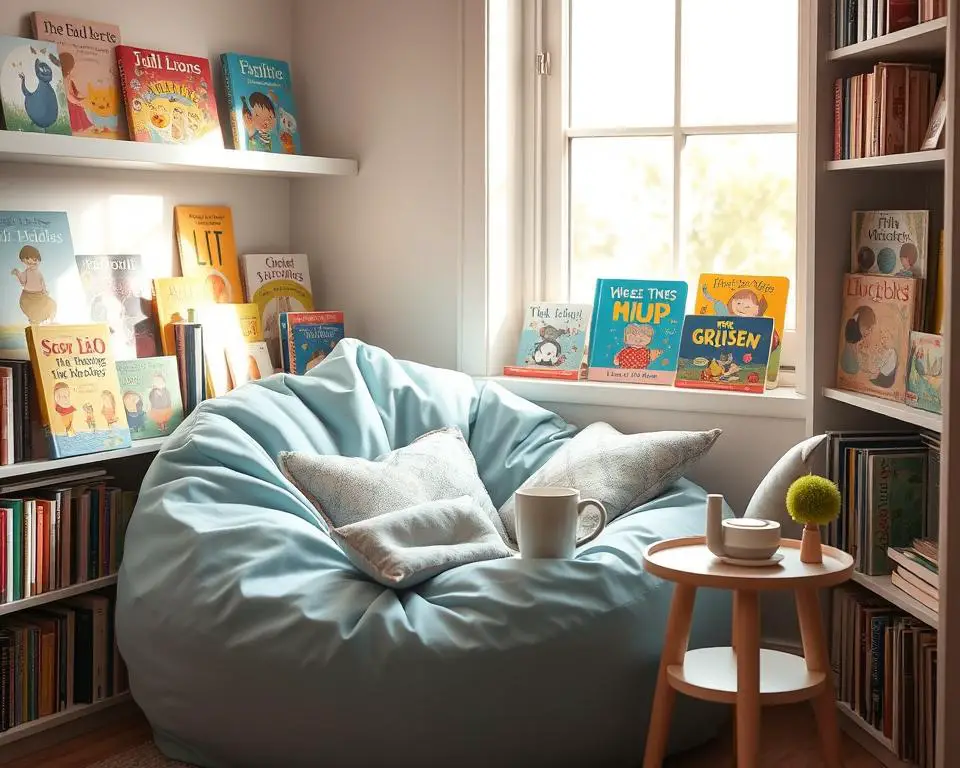
Comfy Seating and Cozy Pillows
Soft, durable pillows and cushions are the heart of any cozy corner. They encourage long reading sessions and make the space inviting. Choose fabrics that are easy to clean and colors that brighten the area.
Proper seating is equally important. A small bean bag, cushioned bench, or floor chair can provide both comfort and posture support. Ensure the furniture fits your child’s size for a perfect fit.
Optimal Book Storage and Display
Accessible storage solutions keep books organized and within reach. Low shelves or cubbies are ideal for young readers. They allow your child to easily pick their next adventure.
Displaying books with covers facing outward can spark curiosity. Use wall-mounted racks or open bins to showcase favorites. This not only adds charm but also encourages exploration.
“A well-organized space fosters independence and a love for stories.”
| Element | Purpose |
|---|---|
| Pillows and Cushions | Provide comfort and encourage longer reading sessions. |
| Seating | Supports posture and fits the child’s size. |
| Book Storage | Keeps books organized and accessible. |
| Display Solutions | Showcases books to spark interest. |
Every detail, from the pillows to the storage, contributes to a nurturing environment. By combining function with style, you’ll create a space your child will love to return to.
Creative DIY Woodwork and Custom Bench Ideas
Building a custom bench can transform any corner into a functional and stylish retreat. It’s a project that combines practicality with creativity, offering a cozy spot for reading and extra storage for books or toys. Let’s dive into how you can create this versatile piece of furniture.
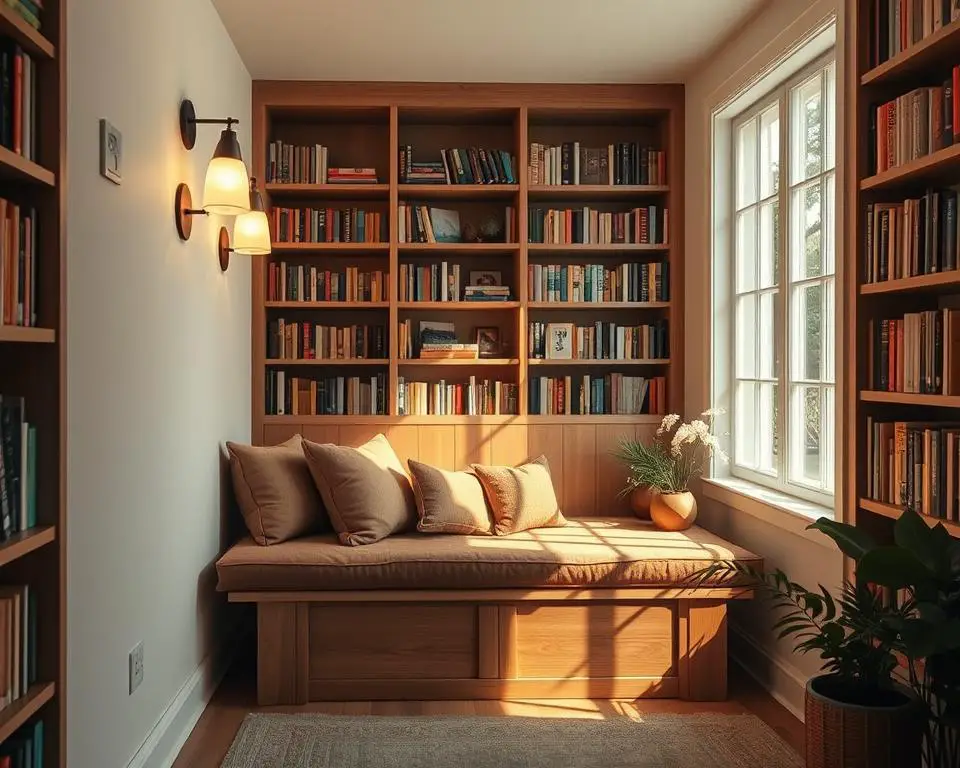
Step-by-Step Bench Assembly Process
Start by gathering your materials. You’ll need maple furniture-grade plywood, a track saw, and a Kreg jig for pocket holes. Measure and cut the panels according to your design, ensuring precision for a seamless fit.
Next, assemble the seat backs and bench top. Use wood glue and pocket holes to secure the pieces. Align the angles carefully, especially if your design includes a 37° slant for added comfort. This step ensures stability and durability.
Once the main structure is complete, sand the surfaces to remove rough edges. Apply clear shellac for a polished finish, followed by paste wax for added protection. Finally, attach rubber feet to prevent slipping and protect your floors.
Materials, Tools, and Workshop Tips
Here’s a quick checklist of what you’ll need:
- Materials: Maple plywood, wood glue, clear shellac, paste wax, rubber feet.
- Tools: Track saw, Kreg jig, sandpaper, clamps.
Safety is key when working with sharp tools. Always wear protective gear and work in a well-ventilated area. Take your time to measure twice and cut once to avoid mistakes.
“A well-built bench not only serves as a seat but also enhances the overall design of the room.”
This project is perfect for maximizing space in smaller areas. The bench can double as a shelf or storage unit, making it a practical addition to any room. Plus, the satisfaction of creating something with your own hands is unmatched.
Whether you’re a seasoned woodworker or a beginner, this guide breaks down the process into manageable steps. With a little effort, you’ll have a beautiful and functional bench that your child will love.
Maximizing Space with Clever Nook Conversions
Unused spaces in your home can become magical retreats with a little creativity. Whether it’s a closet or a neglected corner, these areas hold the potential to transform into cozy spots for your child to enjoy books. I’ve discovered that repurposing these spaces not only maximizes functionality but also adds charm to any room.
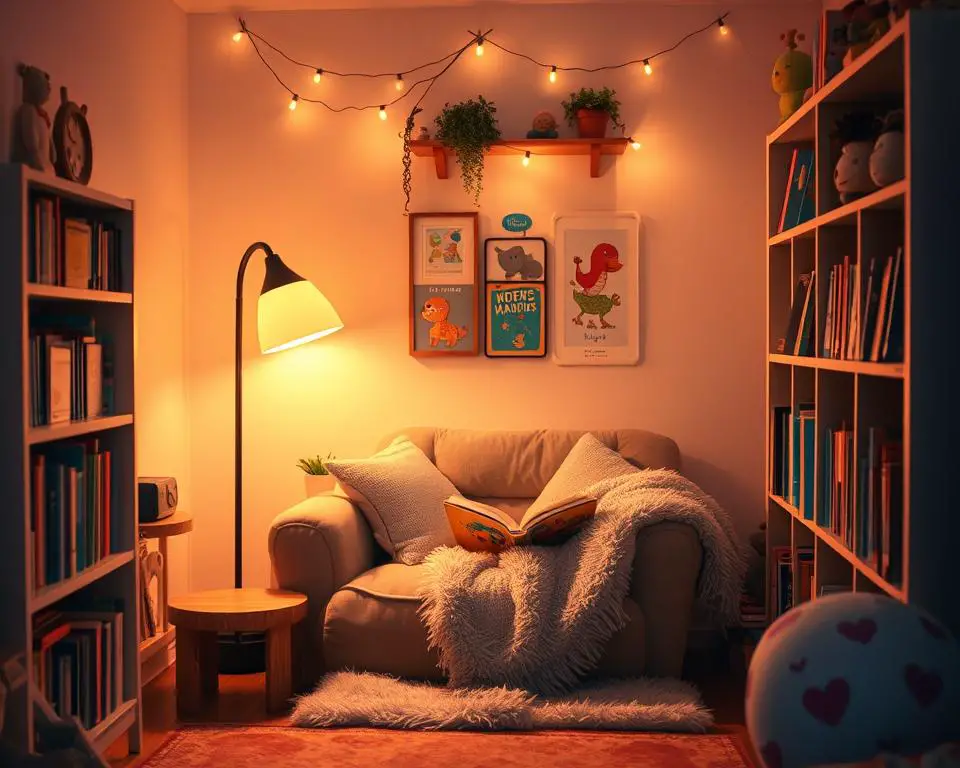
Transforming Closets and Corners
Closets are often overlooked, but they’re perfect for creating a dedicated reading space. Start by clearing out the clutter and adding a soft cushion or bench. Install shelves for books and decorative items to make the area inviting. A small lamp or string lights can add warmth and make the nook feel special.
Corners, too, can be transformed with minimal effort. A bean bag or floor chair paired with a small shelf can turn an empty corner into a cozy retreat. Use wall decals or artwork to personalize the space and make it uniquely your child’s.
“Even the smallest space can become a cherished spot with thoughtful design.”
Here are some tips to make the most of your conversions:
- Use vertical storage solutions like wall-mounted shelves or hanging organizers.
- Choose lightweight, movable furniture for flexibility as your kid grows.
- Incorporate soft lighting to create a calming atmosphere.
- Opt for durable, easy-to-clean materials to ensure longevity.
By reimagining these spaces, you’ll not only maximize your home’s potential but also create a special place where your child can escape into the world of books. It’s a simple yet impactful way to encourage a love for stories.
Lighting and Ambience: Setting the Perfect Mood
Lighting can turn a simple corner into a magical escape for your child. The right combination of natural and artificial light creates an inviting atmosphere that encourages longer reading sessions. Whether it’s a sunny spot by the window or a cozy nook with twinkling fairy lights, thoughtful lighting choices make all the difference.
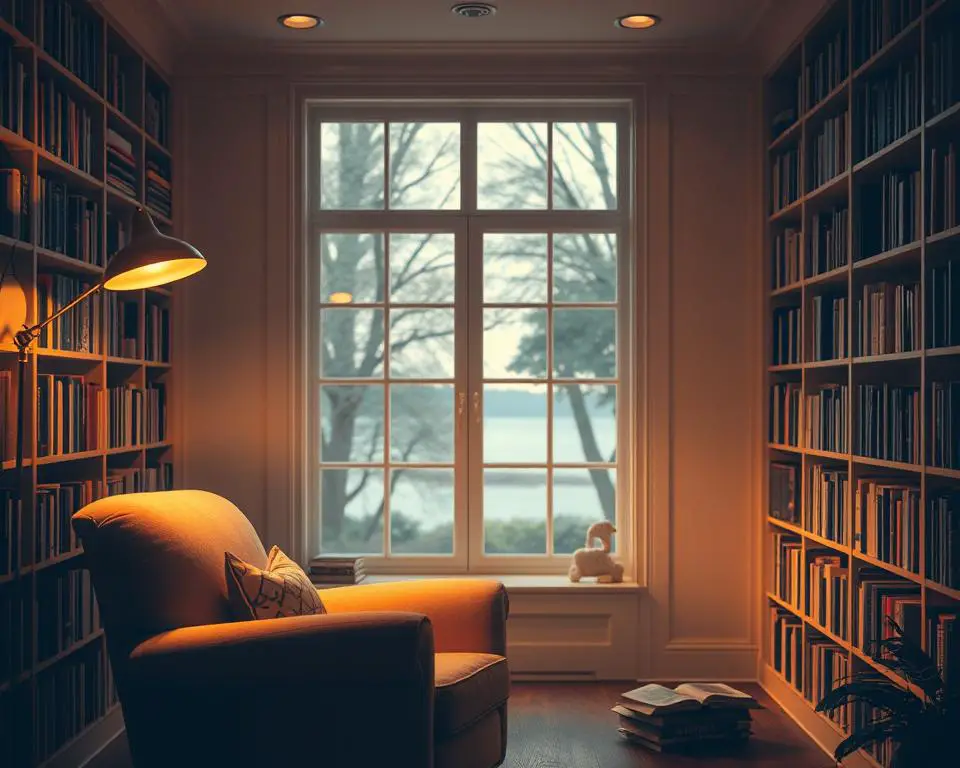
Natural Light and Window Treatments
Natural light is the foundation of a welcoming space. Position the reading nook near a window to take advantage of daylight. This not only brightens the area but also reduces eye strain during long reading sessions.
Window treatments like sheer curtains or blinds allow you to control the amount of light entering the room. Opt for soft, neutral colors that complement the decor while maintaining a calming vibe. These small adjustments can significantly enhance the overall ambiance.
Mood Lighting with Fairy Lights and Lamps
When the sun sets, mood lighting takes center stage. Fairy lights are a popular idea for adding a touch of magic to any space. Drape them around the seat or along the walls to create a warm, enchanting glow.
Lamps with low-watt bulbs are another excellent option. Place a small table lamp or floor lamp near the cushion for focused lighting. This ensures your child can read comfortably without straining their eyes.
“Balanced lighting is essential for both aesthetics and eye care. It’s the perfect way to blend functionality with a touch of magic.”
Layered lighting effects, combining overhead lights with softer accents, create depth and warmth. Experiment with different setups to find what works best for your space. Subtle changes in lighting can completely transform the feel of the reading nook, making it a cherished spot for your child.
Personalizing the Reading Nook for Your Child
A child’s favorite stories can inspire a space that feels uniquely theirs. Personalizing a reading nook not only makes it inviting but also encourages a deeper connection to books. By incorporating their interests and preferences, you create a spot they’ll love to return to.
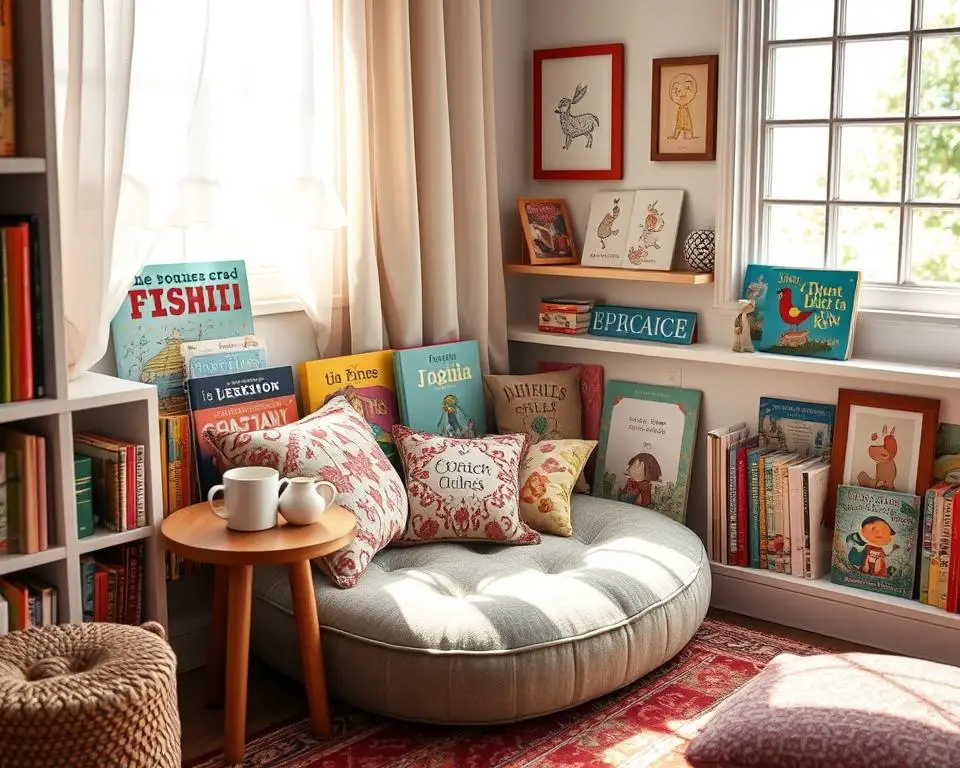
Incorporating Favorite Books and Characters
Start by showcasing their favorite book or series. Use low, accessible shelves to display covers facing outward. This not only sparks curiosity but also makes it easy for your child to pick their next adventure.
Wall decals or artwork featuring beloved characters add a playful touch. For example, a mural of a magical forest or a galaxy can turn the reading space into an immersive experience. These elements make the area feel like it’s truly theirs.
DIY Décor and Personalized Accessories
DIY projects can add a unique flair to the nook. Use colorful fabric to create custom cushions or curtains. These small touches reflect your child’s personality and make the space feel special.
Personalized accessories, like name plaques or themed bookends, add charm. Encourage your child to help with these projects. Their input ensures the idea resonates with their interests and makes the space truly unique.
“A personalized space fosters a sense of ownership and pride in their reading corner.”
| Element | Purpose |
|---|---|
| Favorite Books | Encourages engagement and familiarity. |
| Wall Art | Creates an immersive and playful atmosphere. |
| DIY Cushions | Adds comfort and reflects personal style. |
| Personalized Accessories | Makes the space feel uniquely theirs. |
By combining these elements, you’ll create a reading space that’s both functional and meaningful. It’s a place where your child can escape into their favorite stories and feel at home.
Safe and Durable Designs for Growing Kids
Safety and durability are the foundation of any space designed for children. When creating a reading nook, it’s essential to ensure every element is secure and built to last. From the materials used to the construction methods, every detail matters.
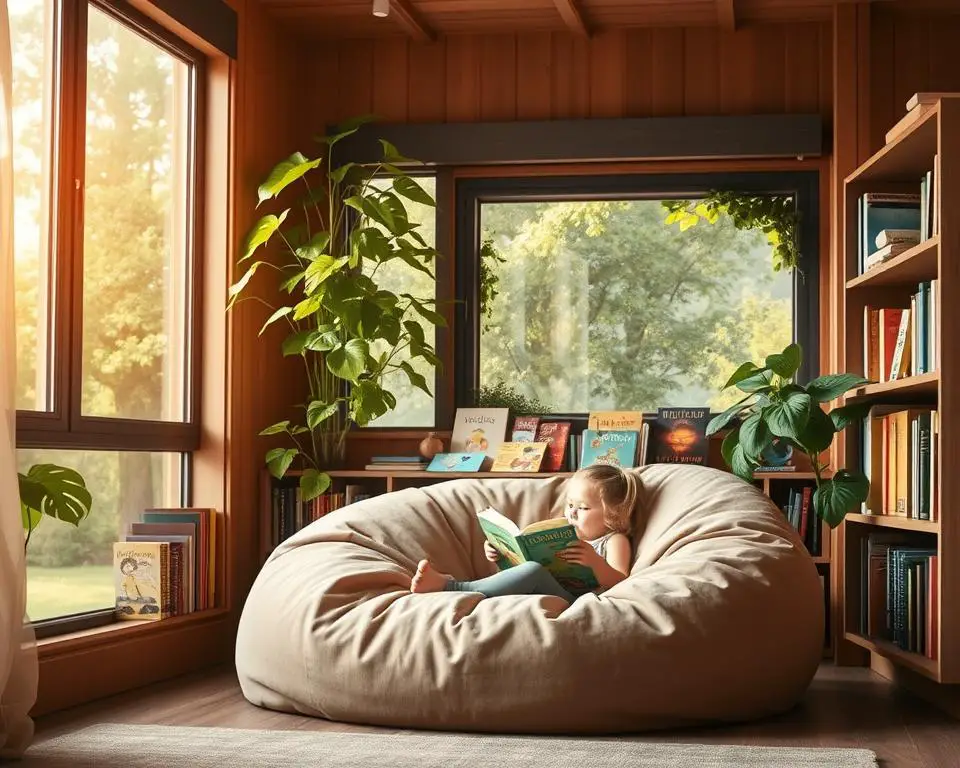
As a parent, I’ve learned that a safe environment fosters creativity and peace of mind. Let’s explore how to design a space that grows with your child while keeping safety at the forefront.
Choosing Child-Safe Materials
Non-toxic, durable materials are a must for any kid-friendly space. Opt for finishes free from harmful chemicals, such as water-based paints and natural wood. These choices ensure the area is safe for your child to enjoy for years.
For cushions and fabrics, choose flame-resistant and easy-to-clean options. This not only enhances safety but also makes maintenance a breeze. Always check for certifications to guarantee the materials meet safety standards.
Ensuring a Secure and Stable Build
Stability is key when designing furniture like a bench or seating. Reinforce joints with sturdy hardware and avoid sharp edges. A well-built piece ensures your child can use it safely without risk of tipping or injury.
Regular maintenance is also crucial. Tighten screws and inspect the structure periodically to ensure long-term stability. A secure build not only protects your child but also extends the life of the furniture.
“Safety should never be compromised for style. A well-designed space can be both beautiful and secure.”
| Element | Safety Tip |
|---|---|
| Materials | Choose non-toxic, durable options like natural wood. |
| Furniture | Reinforce joints and avoid sharp edges. |
| Fabrics | Opt for flame-resistant, easy-to-clean materials. |
| Maintenance | Regularly inspect and tighten hardware. |
By prioritizing safety and durability, you create a space that’s not only functional but also a haven for your child. Thoughtful design ensures the reading nook remains a cherished spot for years to come.
Practical Storage Solutions for Books and Toys
Keeping books and toys organized doesn’t have to be a chore—it can be fun and functional. A well-designed storage system not only declutters the space but also makes it easier for your child to access their favorite items. Let’s explore some creative ideas to maximize every inch of your reading space.
Innovative Shelving and Cubby Ideas
Shelves and cubbies are the backbone of any organized reading nook. Built-in shelves can be customized to fit any corner, while freestanding units offer flexibility. For example, a ladder-style bookshelve adds a playful touch while saving floor space.
Cubbies are another great option. They can hold books, toys, and even art supplies. Label each cubby with colorful tags to make it easy for your child to find what they need. This approach encourages independence and keeps the area tidy.
Here are some tips for integrating storage into a small space:
- Use vertical space with wall-mounted shelves or hanging organizers.
- Choose modular units that can be rearranged as your child grows.
- Incorporate open bins or baskets for quick cleanup.
“A well-organized space fosters independence and a love for stories.”
Innovative designs can make storage both practical and playful. For instance, a bench with hidden compartments doubles as seating and book storage. Or, try a themed bookshelve shaped like a tree or house to add a whimsical touch.
| Storage Idea | Benefits |
|---|---|
| Built-in Shelves | Maximizes space and fits seamlessly into the design. |
| Cubbies | Keeps items organized and easily accessible. |
| Modular Units | Adapts to changing needs as your child grows. |
| Hidden Compartments | Combines functionality with a clean, clutter-free look. |
By incorporating these ideas, you’ll create a reading space that’s both organized and inviting. A tidy area not only enhances the overall experience but also encourages your child to spend more time with their favorite books.
DIY Reading Nook For Kids on a Budget
Creating a cozy spot for your child doesn’t have to cost a fortune. With a little creativity and resourcefulness, you can design a magical reading nook that inspires a love for books. Let’s explore budget-friendly ideas that prove style and functionality can go hand-in-hand with smart budgeting.
Start by repurposing items you already have. An old chair, a wooden crate, or even a stack of pillows can become the foundation of your nook idea. Thrift stores and garage sales are goldmines for affordable furniture and decor. Look for items like small shelves, soft cushions, or whimsical lamps that can add charm without breaking the bank.
For book storage, consider low-cost solutions like wall-mounted racks or open bins. These keep stories within reach and encourage your child to explore. Pre-loved books are another great way to save money. Check out local libraries, secondhand stores, or online marketplaces for gently used titles.
“A well-designed space doesn’t have to be expensive. It’s about creativity and making the most of what you have.”
Lighting can set the perfect mood without costing much. String lights or a small desk lamp can create a warm and inviting atmosphere. Soft textiles, like blankets or curtains, add comfort and can often be found at discount stores.
- Repurpose everyday items like crates or pillows for seating.
- Shop thrift stores for affordable furniture and decor.
- Use wall-mounted racks or bins for book storage.
- Add soft lighting and textiles for a cozy feel.
By focusing on creativity and resourcefulness, you can design a reading nook that’s both inspiring and budget-friendly. It’s a space where your child can escape into their favorite stories without costing a fortune.
Hands-On Guide: Tools, Materials, and Assembly Steps
With the right tools and materials, creating a custom bench is easier than ever. This guide breaks down the process into clear, actionable steps to help you build a cozy reading space. Whether you’re a seasoned woodworker or a beginner, these instructions ensure precision and safety.
Cut Lists and Material Breakdown
Start by gathering your materials. You’ll need maple plywood, a track saw, and a Kreg jig for pocket holes. Measure and cut the panels according to your design, ensuring precision for a seamless fit. Here’s a quick breakdown of the steps:
- Measure and mark the plywood for the bench seat and backrest.
- Use a track saw to cut the panels to size.
- Drill pocket holes for secure assembly.
Accuracy is key. Double-check measurements to avoid mistakes and ensure a stable build.
Finishing Touches and Cushion Assembly
Once the main structure is complete, sand the surfaces to remove rough edges. Apply clear shellac for a polished finish, followed by paste wax for added protection. This ensures durability and a professional look.
For the cushion, use high-density foam and batting for comfort. Cut the foam to size and wrap it with batting. Secure the fabric using a staple gun, ensuring a tight fit. This adds both comfort and style to your bench.
“A well-built bench not only serves as a seat but also enhances the overall design of the room.”
| Step | Details |
|---|---|
| Cutting Panels | Measure and cut plywood for seat and backrest. |
| Assembly | Use pocket holes and wood glue for secure joints. |
| Finishing | Sand, apply shellac, and add paste wax for protection. |
| Cushion | Use foam, batting, and fabric for a comfortable seat. |
By following these steps, you’ll create a functional and stylish bench that transforms any corner into a cozy reading space. Safety and precision are key, so take your time and enjoy the process.
Real-Life Inspirations and Successful Makeovers
Seeing a space transform into a cozy retreat is always inspiring. Real-life examples show how simple changes can create a completely new atmosphere. From dull corners to vibrant spots, these makeovers prove that thoughtful design can turn any area into a magical escape.
Before and After Nook Transformations
One family turned an unused closet into a whimsical reading nook for their child. They added soft cushions, a colorful rug, and wall decals of their favorite storybook characters. The result was a space that felt both cozy and magical.
Another project involved a small corner in a living room. By adding a custom bench, open shelves, and fairy lights, the area became a dedicated spot for books. The transformation was dramatic, proving that even the smallest spaces can be functional and beautiful.
Case Studies from Real Homes
A family in Texas shared their journey of creating a themed reading nook. They chose an underwater theme, using blue fabric for cushions and wall decals of fish and coral. The project took just a weekend but made a lasting impact on their child’s love for stories.
Another example comes from a New York apartment. The parents repurposed an old armchair and added a small table lamp. They used a mix of textures, like a soft rug and knitted blankets, to create a warm and inviting atmosphere. The result was a space that encouraged daily reading sessions.
“Transforming a space with creativity and effort brings immense satisfaction. It’s not just about the look—it’s about creating a place where stories come to life.”
| Project | Key Changes | Outcome |
|---|---|---|
| Closet Nook | Soft cushions, wall decals, colorful rug | Cozy and magical space |
| Living Room Corner | Custom bench, open shelves, fairy lights | Functional and beautiful area |
| Underwater Theme | Blue fabric, fish decals, themed cushions | Engaging and immersive environment |
| Repurposed Armchair | Soft rug, knitted blankets, table lamp | Warm and inviting atmosphere |
These real-life examples highlight the power of creativity and effort. Whether it’s a closet, a corner, or a themed space, a personalized reading nook can make all the difference. It’s a place where stories come alive and memories are made.
Conclusion
Designing a special corner for stories can spark endless imagination. Throughout this guide, I’ve shared how a cozy reading nook can inspire creativity, focus, and a love for books. From choosing the perfect spot to adding personalized touches, every detail matters.
Creating this space doesn’t have to be complicated. Simple changes, like soft cushions, warm lighting, and accessible storage, can make a big impact. Safety and durability ensure the area grows with your child, making it a lasting retreat.
I encourage you to try one of these ideas with confidence. Whether it’s a themed corner or a repurposed closet, the possibilities are endless. Thank you for joining me on this journey—I’d love to see your creations! Share your projects and inspire others to create their own magical nook idea.
Remember, even small changes can transform a corner into a cherished escape. Let’s continue to foster a love for stories and creativity in every child. Happy building!
FAQ
How do I choose the right spot for a kid’s cozy corner?
Look for a quiet, well-lit area in your home, like a corner or near a window. Natural light and minimal distractions make it perfect for a relaxing spot.
What are some creative themes I can use for a child’s nook?
Themes like fairy tale teepees, enchanted forests, underwater adventures, or space explorations can spark imagination and make the space feel magical.
What seating options work best for a kid-friendly space?
Comfy cushions, bean bags, or a custom bench with soft pillows are great choices. They provide comfort and encourage kids to spend time there.
How can I maximize storage in a small reading area?
Use wall-mounted shelves, cubbies, or under-seat storage to keep books and toys organized without taking up too much floor space.
What materials are safe and durable for a child’s nook?
Opt for non-toxic, sturdy materials like solid wood or child-safe fabrics. Avoid sharp edges and ensure everything is securely assembled.
How can I personalize the space to reflect my child’s interests?
Add their favorite books, characters, or DIY décor like framed artwork or a canopy. Let them help choose colors and accessories to make it their own.
What lighting works best for a cozy reading spot?
Combine natural light with soft mood lighting, like fairy lights or a small lamp. It creates a warm and inviting atmosphere.
Can I create a reading nook on a budget?
Absolutely! Repurpose furniture, use affordable materials, and add DIY touches like handmade cushions or painted shelves to keep costs low.
How do I ensure the nook is safe for my child?
Secure all furniture to the wall, avoid small or sharp objects, and use non-slip rugs. Regularly check for stability and wear.
What tools do I need to build a custom bench or shelf?
Basic tools like a saw, drill, sandpaper, and screws are essential. Follow step-by-step guides and safety precautions for a smooth build.

